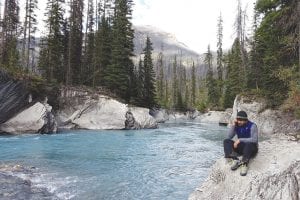Intrepid explorer Lonnie Dupre, talking on his cell phone, sits comfortably on a ledge of granite in British Columbia while a river fueled by snowmelt flows coolly by. Dupre used his visit to British Columbia to train for his trip to Nepal where he led an expedition to climb Langju, a mountain in the Himalayas. Nearing the summit at more than 18,000 feet, the snow became too risky to walk on, and fearing an avalanche, Dupre led his Vertical Nepal team back down the mountain. The group is still in Nepal working with The Rose International Fund for Children, whose mission is to improve the lives of children with disabilities in Nepal.

After eight days on the mountain, Grand Marais adventurer Lonnie Dupre and his Vertical Nepal team agreed to end their climb of Langju, a 20,885-foot mountain in the Himalayas.
Fearing avalanches, they were less than 3,000 feet from the summit when they turned and headed back down.
After establishing a base camp at 18,200 feet, two climbers went ahead to find a suitable route to the peak but were unable to do so, running into an area not possible to climb with the gear they had brought with them and dealing with hard slabbed snow—sitting on top of sugar snow.
“This is the perfect environment for avalanches,” said Dupre from his blog. A Sherpa who was helping them was shaken up, said Dupre, because he had lost a friend to an avalanche just a few weeks before the Vertical Nepal climb.
“So we decided to come back down and live to climb another day,” Dupre said. “Still, it was incredible to realize that we were the first ones to climb this mountain.”
The group of four, plus a Sherpa, began their ascent on October 23rd and hoped to finish by November 10th.
Doing the climb with Dupre were Elias de Andres Martos, who grew up in the mountains of Spain. Pascale Marceau was raised in Sudbury, Ontario and has transitioned from the life of an engineer to a life as a consultant and now lives in the Canadian Rockies where she is focused on climbing and alpinism. Bridget Schletty was raised in St. Paul and currently spends winters leading climbing trips in Colorado.
Langju, as described by Dupre, “is a majestic stand-alone peak in the remote Tsum Valley; an attempt at its first ascent is the focus of this five-week expedition.”
Nepal is the home of nine of 10 tallest peaks in the world. Recently the government opened some of the 20,000-foot-tall peaks to climbers, which was good news to Dupre who had been interested in that area for years.
Just because the team didn’t reach the peak, didn’t mean their work was done. Coming down, Vertical Nepal collected water samples from high altitude lakes, streams, glaciers, and took snow samples. These samples will be sent to Adventures Scientists, which will test the water samples taken from various altitudes to see if they contain microplastics.
Microplastics (plastic particles), said Dupre, “enter our waterways and pose an environmental and human health risk when they enter the food chain.
“The goal is to understand the sources of origin to curb microplastics pollution,” added Dupre.
Animal scat samples were also collected and sent to a lab for testing. Through scat samples, scientists hope to create a genetic library that can be used for early detection of wildlife diseases. The last sample of scat was from a Nepali blue sheep.
As they came back down, they entered the steep green verdant valleys.
At 13,000 feet Dupre said they were back in “banana trees and bamboo.”
During the eight days on the mountain, the larch trees they had left behind had turned color. As Dupre said, the crew had returned from the glaciers to the geckos, “quite a radical shift,” he added.
Except for some sinus problems, the team remained in good health. They stayed at a monastery, waking up to the sounds of gongs and monks praying.
On Halloween, they bought Snickers bars to eat and celebrated the day resting.
Once they are off of the mountain Vertical Nepal will spend a couple of weeks volunteering their time with The Rose International Fund for Children (TRIFC), whose mission is to improve the lives of children with disabilities in Nepal.
And as Dupre said, they will live to climb another day.


Loading Comments